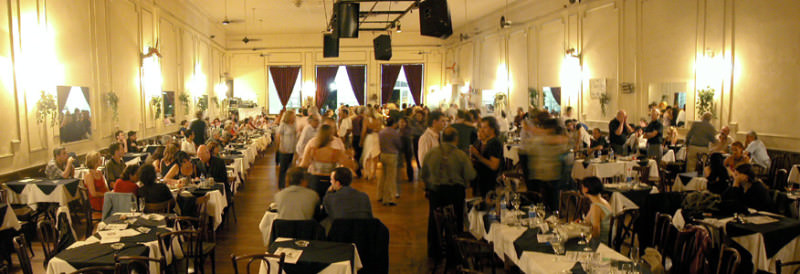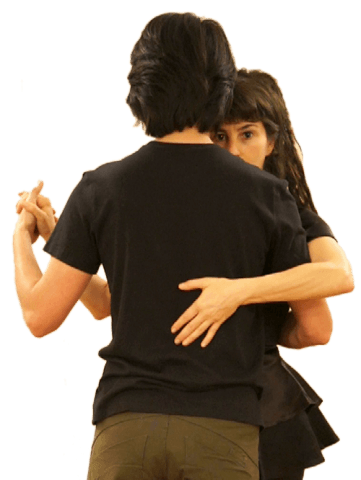In Buenos Aires the worst thing that can happen to you at a milonga is not to find a table.
Most milongas are organized with large tables for 6-10 chairs (a few 4-tops and fewer still 2-tops for couples). When you enter a milonga you look at the tables to see who you know and which of them you want to sit with. Sometimes you are looking for anyone you know. It could be a friend from school. It could be a teacher. You circulate, kissing people hello, needing an invitation, hoping for a good one. You don’t want to have to ASK “can I sit with you?“
You can see that some of the tables belong to importantes. These have champagne buckets. If it’s a lucky night one of the teachers you spend money on is there and invites you. But even a student at his table may do so. In this sense the cliques are permeable and the elitism is egalitarian. (Such contradictions are the core of Porteño culture.)
By finding a table you ascend the first step of the hierarchy. At a table, you are never alone. Even if everyone else is dancing, you are obviously part of a group. Once you are sitting, you too are a host, watching out for arriving friends or handsome tourists who need a place.
At a table, with up to 10 people circulating back to each chair (depending how welcoming your table is), you meet people. These are potential new dance partners. And the oversubscribed tables do not stand on the perimeter of the room. It’s important that many (if not all) of the tables cluster, to facilitate a dense field of cabeceo among the tables. As you can see in the photo below of Niño Bien in Buenos Aires, the tables take as much of the floor as the dancing. Because what happens in the tables is just as important! (To the dancing!)

Berlin milongas don’t have tables, or only tables appropriate for couples. (This is interesting given the history of people not changing partners during the early years of tango here. See interview with DJ Jens Stuller.)
In Berlin, if you are lucky you get a chair, to wait in and to which you are not attached. Dancers in Berlin milongas are in perpetual solitary motion and circulation. Democratic and egalitarian perhaps, but also lonely. Which is this city.
There are many things not to like about tango in Sydney. In fact I think I even once wrote that tables are bad in Sydney because they reinforce the fractious factions’ territories. But when I first got established there I was asked by the organizer of a big event if I wanted a table. To this table all my students came and invited friends. It was so nice. I learned that the table is a tool to take care of people, to introduce dancers to each other in a casual way. (I don’t mind dragging them by the hand across the room, but it’s far more gracious at a table.) Tables beget a proliferation of hosts. (It reflects badly on an importante to have an un-full table.) And this is good for a milonga.
Last week here in Berlin I told my students “let’s meet at Clärchens and whoever gets there first take a table in this corner.” It was a table for 4, there were 8 of us. Perfect. But Clärchens is the only place in Berlin I know of where I could do this.
When I was a community organizer we used to say “putting the chairs in a circle doesn’t make a democracy happen.” In the same way, not having tables doesn’t eliminate cliques. At Nou, the smugsters (‘Smug Tango’ is my new name for the neo-Victorian phenomenon) cluster standing behind the barrier of a thick column. It reminds me of a debutante party, where the rich make sure their children only marry each other. It takes a lot of chutzpah to go stand in the midst of their cocktail party, hoping for a glance. The hoy-poloi are conciliated with chairs.
At Milonga Popular here in Berlin there is just nowhere to sit, at all whatsoever. (Ok, some deep couches up on a stage, which is a bit like getting in the swimming pool. It’s not an effective border region, there’s no cabeceo out of there.) For me, very uncomfortable, very atomized, very anonymous. You are always alone. You talk to someone and they go dance, and you are standing, leaning against the wall alone. I also feel alone at Nou, even though I can sometimes sit down.
I tend to complain about milongas where I can’t sit in a dignified manner with my wine, a surface to put my glass on, my shoe collection readily at hand, and the possibility to have a conversation. TangoLoft is the only milonga that invites deep conversation. (That was Henning’s vision. He built a living room. See interview.) Every other milonga here is set up only for sitting more or less alone and waiting.
There’s a lot of talk here in Berlin about “social tango”. Mostly people are talking about traffic mechanics on in the dance floor. Some are talking about encouraging beginners (interview with organizers of Tango Kollektiv). But how does this concept apply to the whole milonga? I made friends in Sydney because when I wandered around the milonga looking for a place to sit, people invited me to their table. Sydney dancers may have some confused and rigid ideas about “salon-style dancing” but somehow they’ve got Buenos Aires social style quite right.
In Buenos Aires you have a table with your friends and you spend very much of the night talking and drinking. You get up to dance sometimes. Once I went to a barrio milonga where there was a lot more beer being drunk than dancing. Deep in the table cluster, I forgot about dancing for a while. I certainly wasn’t waiting for anything. That was social.
Oh yeah. One more thing: 8-top round tables don’t work. This is the problem with many festivals. They’re in hotels or conference centers and they rent round tables. Round tables are inward-looking, too big to cabeceo across, and nobody ever notices a handsome stranger passing. Long rectangular tables have more edge per square foot of floor. As permaculturalists note, edge is where the maximum productivity happens, so always maximize it in design.














